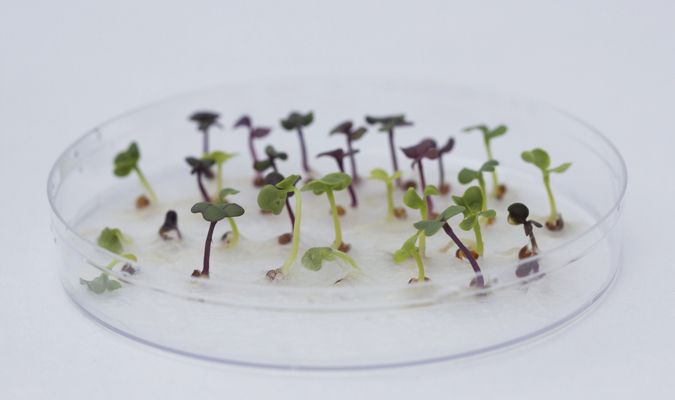My Cart
Your Shopping Cart is currently empty. Use Quick Order or Search to quickly add items to your order!
Hedi Baxter Lauffer
Director of the Wisconsin Fast Plants® Program
Two key questions drive one of the core ideas in life sciences: How are characteristics of 1 generation passed to the next? and How can individuals of the same species and even siblings have different characteristics? Directly addressing these questions, Wisconsin Fast Plants® have been a primary go-to organism that students can easily grow and use to observe firsthand the variation of traits among siblings and between parents and offspring. However, even with just 14 days to flower and approximately 1 month to produce seed, the Fast Plants® life cycle was a little long for some of our schedules. So teachers working with the Fast Plants® Program developed techniques for germinating seedlings on paper toweling in petri dishes, having students observe variation in traits such as stem color in just 3 days.
We can now shortcut even the accelerated petri dish technique, using Fast Plants® to demonstrate Mendelian inheritance patterns with prepared seed disks. The new 72-Hour Genetics Kit contains all the materials needed for 8 student groups to germinate 1 petri dish, each of 2 homozygous parent stocks (purple and non-purple stems), and the first (F1) and second (F2) generations that result from their cross. In just 3 days after adding water to the seed disks and allowing them to germinate under bright light, students can count the numbers of purple and non-purple stemmed seedlings. Then, by pooling results, a single class will generate sufficient data to produce the expected second generation’s (F2) 3:1 ratio.

The Next Generation Science Standards articulate heredity concepts as Disciplinary Core Ideas that are tied to Crosscutting Concepts, including Cause and Effect and the Science and Engineering Practice of Developing and Using Models. You can directly align all 3 of these dimensions with lessons that use the inheritance of stem color in Fast Plants® seedlings as the phenomenon to be explained. The evidence that students collect by observing the variation of stem color in seedlings is very similar to the pea seed color observations that Gregor Mendel used to test his model for explaining inheritance.
In this investigation, students will ask questions about inheritance and conduct an investigation to figure out how the purple stem trait in Wisconsin Fast Plants® is inherited. By the end of the investigation, students will have observed and recorded the stem color of the 2 parental lines and their F1 and F2 generation offspring (all grown in petri dishes).
The timing for when the offspring generations and 2 parental lines are germinated can be varied to change what data students have to work with and the amount of inference required. For example, Parent 2 can be germinated 1 day later so that students must hypothesize about its phenotype and genotype (based on the phenotypes observed in Parent 1 and the F1 generation). Similarly, you can emphasize the practice of modeling by delaying germination of the F2 generation until after students develop and draw models to explain the inheritance pattern they infer. Then, students can use their models to predict the F2 generation outcome before germinating F2 seeds to check their models’ accuracy.
Whatever timing is used—starting all 4 seed lines at once or staggering germination—students will gather evidence that can be used in answering questions such as: How are characteristics of 1 generation passed to the next? and How can individuals of the same species and even siblings have different characteristics? Students will see from analyzing their observations that Wisconsin Fast Plant seedlings inherit 2 genes for this stem color trait, 1 from each parent. The evidence will also show that there are 2 versions (alleles) of the gene for stem color, and the purple allele is dominant, while the non-purple allele is recessive.

In 3 days, seeds will have germinated, and seedlings will clearly show the purple/non-purple stem traits.
Click here for complete instructions for planting the seeds in petri dishes.
Guide students to make careful observations on day 3 and analyze their data. Students can then make inferences about the genotypes based on the 3:1 segregation ratio of the purple stem and non-purple stem phenotypes in the F2 generation.
Note: Once seeds have germinated, the seedlings can be held for 1 or 2 days in a refrigerator if there is need to delay before students make their observations.

Assign student groups to propose a hypothesis for how the stem color trait is inherited in Wisconsin Fast Plants®. Students can practice engaging in argument from evidence to explain how the class data supports or refutes their hypotheses. Have students listen to and respect the different ideas that other groups present, accept the skepticism of others, and consider alternative explanations that are given.
A chi-square test can be used by students to analyze data observed that does not fit their hypotheses.
Visit www.fastplants.org for more information about teaching and learning with Fast Plants®.
